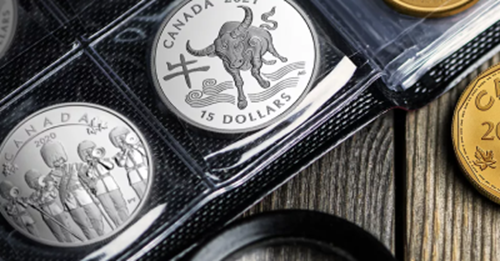
Archived
Pure Gold Coin - Great Canadian Explorers Series: Alexander Mackenzie - Mintage: 1,000 (2017)
2017
Mintage 1,000
Archived
Pure Gold Coin - Great Canadian Explorers Series: Alexander Mackenzie - Mintage: 1,000 (2017)
2017
Mintage 1,000
$844.64 USD
Masters Club:
12,000
Status: CAN & US shipping only
Availability:
Out of stock in stores
About
FINAL COIN IN SERIES! A gorgeous keepsake for art collectors! Order today!
By the late 18th century, explorers and voyageurs were pushing further into western Canada. La Vérendrye and his quest for the "great western sea" had helped spurthe expansion of the fur trade, but the search continued for an overland route to the continent'swestern coast. History credits Sir Alexander Mackenzie (1764-1820) for being the first person on record to achieve this; by reaching the waters of the Pacific in July 1793, Mackenzie holds the distinctionof being the first European to cross the North American continent north of Mexico. The published account of his voyages to Canada's Arctic and Pacific coasts stirred great public interest and inspiredothers to follow, while cementing Mackenzie'sreputation as one of the greatest explorers in Canadian history.
Alexander Mackenzie's two epic voyages pushed deeper than ever into the largely unmappedreaches of western and northwestern Canada. In 1789, his first expedition unexpectedly reached the shores of the Arctic Ocean after following a great river that would later bear his name. In 1793, he fixed his sights on the west once more; setting out in a birch bark canoe with his cousin, two guides, six voyageurs and a dog, Mackenzie heeded the advice of local First Nations as he led his expedition down the Peace, Fraser and Bella Coola Rivers, and portaged overland where necessary. While Mackenzie's determination ultimately brought him to the waters of the Pacific, he was forced to turn back without reaching the open sea—but not before leaving a record of his journey andachievement, with these simple words painted on a rock:
Alex Mackenzie
from Canada
by land
22d July 1793
Own an original work of art depicting one of Canada's most renowned and compelling historical figures. Order today!
Special features:
- FINAL COIN IN SERIES! Sixth and final coin in the popular Great Canadian Explorers series, which commemorates the more than 400 years of exploration that have shaped the history of Canada as we know it today.
- HISTORICAL ACCURACY! Your coin features an outstanding amount of finely detailed engraving, with great care taken to ensure the historical accuracy of this depiction of a pinnacle point in Alexander Mackenzie's transcontinental journey to the Pacific.
- EVIDENCE OF THE EXPLORER'S EPIC JOURNEY! Depicted in your coin, Mackenziestands at the water's edge where he has inscribed the words "Alex Mackenzie from Canada by land 22d July 1793" on a large rock, evidence of the explorer's passage and his epic journey.
- HIGHLIGHTS THE FUNDAMENTAL ROLE OF ABORIGINAL PEOPLE IN CANADA! Instrumental to the success of this expedition is a Nuxalk guide, who is pictured at bottom left with his back turned to theviewer; to the right of Mackenzie stands a member of his expedition, while another helps to carry the dugout canoe loaned by the Nuxalk over the shallow water.
- MULTIPLE FINISHES AND TEXTURES! The multiple finishes on your coin enhance each engraved element in this artfully layered design!
- INCLUDES SERIALIZED CERTIFICATE! The Royal Canadian Mint certifies allof its collector coins. Most of these are serialized certifications, meaning that each certificate is given a unique number, starting at 1.
- 99.99% PURE GOLD COIN! Your coin has no GST/HST!
- LOW MINTAGE: Only 1,000 coins will be made worldwide.
About the Design:
Designed by Canadian artist John Mantha, your coin features a full-length portrait of the greatexplorer, Sir Alexander Mackenzie. Painstakingly engraved in meticulous detail, the scene captures Mackenzie's expedition at the westernmost point of their transcontinental voyage, in a breathtaking inlet surrounded by rocky peaks. Here, the waters ofthe Pacific in the background seem to sparkle witha golden gleam, thanks to the coin's surface and the polished finish. In the foreground, Mackenzie stands at the water's edge where he has inscribed the words "Alex Mackenzie from Canada byland 22d July 1793" on a large rock, as evidence of the explorer's passage and his epic journey. Instrumental to the success of this expedition is a Nuxalk guide, who is pictured at bottom left with his back turned to the viewer; to the right of Mackenzie stands a member of his expedition, while another helps to carry the dugout canoe loaned by the Nuxalk over the shallow water. The entirety of your coin's design boasts a high degree of historical accuracy—particularly in its depiction of the clothing worn by the voyageurs and the traditional cedar hat of the Nuxalk; the coin truly shines as an artistic piece, and an everlasting snapshot of a historic moment in Canadian history.
Did you know…
- Sir Alexander Mackenzie's journals were published in 1801, in a book titled Voyages from Montreal Through the Continent of America to the Frozen and Pacific Oceans in 1789 and 1793; it is said to have inspired U.S. President Thomas Jefferson to commission the famous Lewisand Clark expedition to the Pacific.
- While Mackenzie used a mix of vermillion and bear grease to paint his message, surveyors later helped preserve it by permanently inscribing it in the rock. Today, visitors to Sir Alexander Mackenzie Provincial Park can view the etched inscription on what is known as Mackenzie's rock, which is located near the water's edge on Dean Channel.
- While Mackenzie's expedition travelled overland toward North Bentinck Arm, George Vancouver was exploring the coast by sea—in fact, Vancouver's longboats were exploring the inlet just 48 days before Mackenzie's arrival.
- The Alexander Mackenzie Heritage Trail preserves part of the route used by Mackenzie to reach Bella Coola Valley. Long used by the Nuxalk and Carrier people who led Mackenzie to the inlet, the trail is referred to as a "grease trail"—one that links communities on the coast with those in the interior, and facilitates the trade of oil from the eulachon fish.
About Mackenzie
Born in Scotland in 1764, Alexander Mackenzie (1764-1820) made his first journey across the Atlantic in1774 when his widowed father moved the family to New York City. But with the onset of the American Revolution, Mackenzie's father and brother joined the King's Royal Regiment of New York; Mackenzie was sent to live with his Loyalist family upstate, and then further north to the bustling centre of North America's fur trade: Montreal.
Still a teenager, Mackenzie became a junior clerk in the fur-trading company of Finlay and Gregory, where he shined. He was offered a share inthe business—but on condition that he would take charge of the trading post in Grand Portage, which he did from 1785 until the firm merged withthe North West Company in 1787.
In the winter of 1787-88, Mackenzie was assigneda post on the Athabasca River, in present-day northern Alberta, where he co-founded Fort Chipewyan. Itwas during this time that Mackenzie learned much from Peter Pond; Pond was inspired by the stories of the Dene First Nations about a great river, and believed this would lead to the western coast. Mackenzie decided to test this theory; in 1789, he assembled a small expedition and set off along the Slave River to Great Slave Lake, then paddled on the long river that would later bear his name. But the party eventually discovered they were heading north, not west; on July 14, 1789, the expedition reached the river's terminus at the Arctic Ocean, where theyturned back towards Fort Chipewyan.
Disappointed but undeterred, Mackenzie secured permission from the North West Company to assemble another expedition. On October 10, 1792, Mackenzie set out on the Peace River with a team of two First Nation guides, his cousin, six voyageurs and a dog. They wintered at Fort Fork before setting out again on May 9, 1793. Portaging southward across the Rocky Mountains, Mackenzie followed traditional trading routes to the Fraser River,where the Carrier people advised him to turn west towards the Bella Coola Gorge. After borrowing canoes from the Nuxalk people, Mackenzie ultimately reached his goal in July at North Bentinck Arm—there, in the inlet, lay the waters of the Pacific.
Mackenzie had made history as the first European to journey cross the North American continent, across what is present-day Canada. The expedition pressed on towards the open sea, but a hostile encounter with the warriors of the Heitsulk nation meant they could go no further. Before turning back, Mackenzie recorded his passage and journey by mixing vermillion and bear grease to paint "Alexander Mackenzie/from Canada by land/22d July 1793" on a rock, which still bears the inscribed message today.
In 1801, Mackenzie's journals were published in a book titled Voyages from Montreal Through the Continent of America to the Frozen and Pacific Oceans in 1789 and 1793. The book brought him widespread acclaim and recognition as a celebrated explorer, and was knighted in 1802 for his achievements. He served as a member of the Legislative Assembly of Lower Canada between 1804 and 1808 but retired to Scotland, where he married in 1812. Mackenzie died of Bright's disease in 1820 at the age of 56.
Packaging:
Your coin is encapsulated and presented in a Royal CanadianMint-branded maroon clamshell with a black beauty box. Order your coin today!
Specifications
Product Number
156285
Mintage
1,000
Composition
99.99% pure gold
Weight
15.43 g
Edge
serrated
Certificate
serialized
Face Value
200 dollars
Finish
proof
Artist
John Mantha (reverse), Susanna Blunt (obverse)
Reviews
Questions
What do you want to know about this product?






